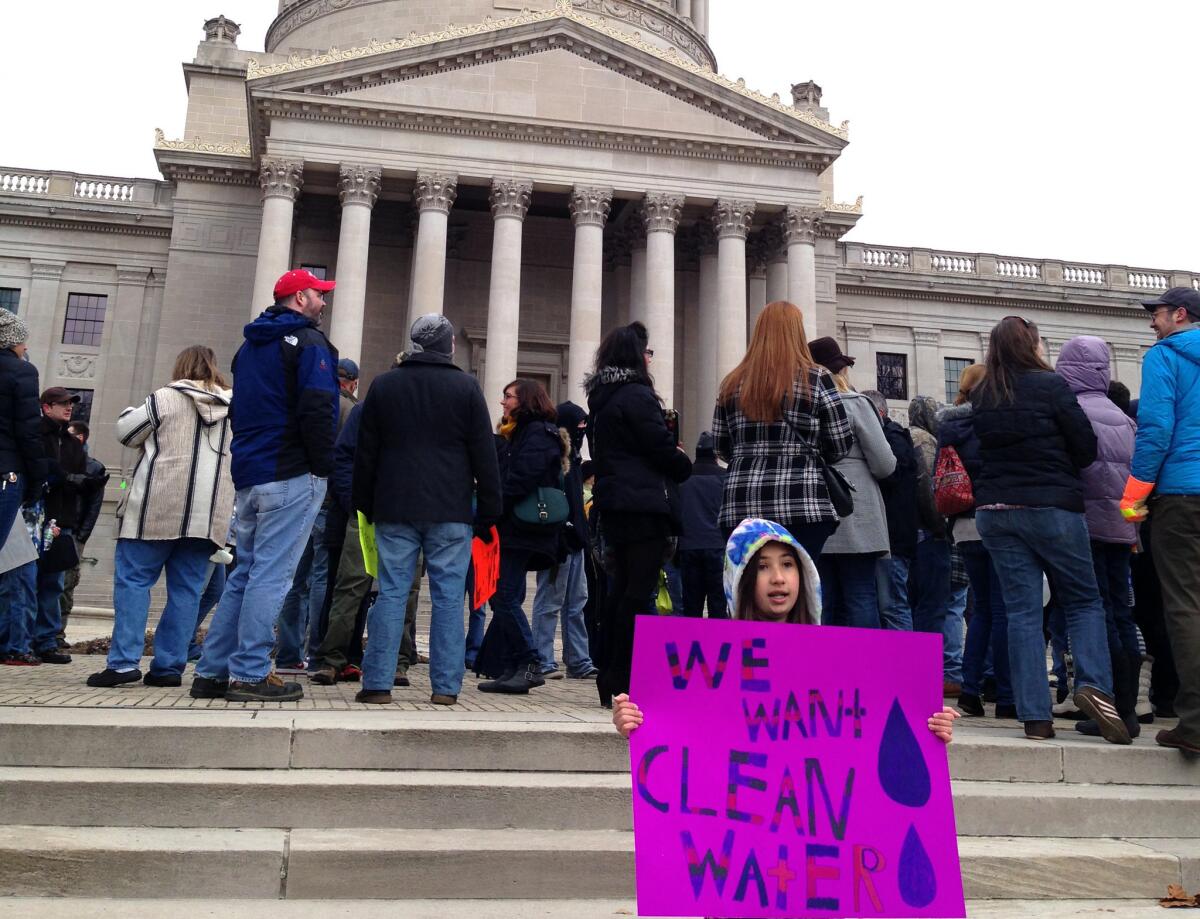Tainted West Virginia water: Formaldehyde in the shower

- Share via
First, federal regulators couldn’t explain the possible health dangers posed by the mysterious coal-cleansing chemical that spilled into West Virginia’s drinking water -- except that pregnant woman shouldn’t drink it even after the water had been declared safe for everyone else.
Then the chemical company responsible for the spill belatedly admitted a second, equally unpronounceable chemical containing ether also had been dumped into the water.
Now comes this warning for hundreds of thousands of West Virginians: They may be inhaling formaldehyde while showering in the tainted water, which was declared safe for human consumption a week after the Jan. 9 spill into the Elk River just north of downtown Charleston.
“I can guarantee you that citizens in this valley are, at least in some instances, breathing formaldehyde,’’ Scott Simonton, a Marshall University environmental scientist and member of a state water quality board, told a legislative committee in Charleston on Wednesday.
“It’s frightening, it’s really frightening,” Simonton told the panel. He said he and his family are not drinking or cooking with the water, even though state and federal authorities have declared it safe for all uses.
Formaldehyde is listed by the Environmental Protection Agency as a likely human carcinogen that has caused cancer in animals. The EPA says the colorless, pungent gas can cause burning sensations in the eyes and throat, nausea and breathing difficulties in exposure to elevated levels, defined as above 0.1 parts per million. It can also trigger several allergic reactions.
Formaldehyde is used in plywood, paneling, particleboard and furniture, and as an adhesive and a preservative in paints.
[Updated, 3:25 p.m. Jan. 29: “Formaldehyde is a ubiquitous, naturally occurring substance produced by every living organism,” the American Chemistry Council’s Formaldehyde Panel said in a statement. “Studies show that formaldehyde is readily biodegradable and does not accumulate in either the environment or in people. In the environment, formaldehyde is quickly broken down in the air by sunlight or by bacteria in soil or water.”]
Simonton, a member of West Virginia’s Environmental Quality Board, said he found traces of formaldehyde in water samples taken at a popular restaurant in downtown Charleston, but he did not specify the concentration. Other testing showed no traces of the chemical, but other samples are still being tested.
“The problem is, we’re seeing it in water,’’ Simonton said in remarks first reported by the Charleston Gazette. “We don’t know what the concentration is in the air.’’
According to Simonton, methanol in the chemical that spilled into the water supply, 4-methylcyclohexanemethanol, or MCHM, can break down into formaldehyde.
“This stuff is breaking down into formaldehyde in the shower or in the water system, and they’re inhaling it,’’ Simonton said of some of the 300,000 residents of nine West Virginia counties told not to use their tap water in the days after the spill.
Other environmental scientists said in published interviews that more testing is required to confirm the formaldehyde came from the chemical spill and was not present before the incident.
Richard Denison, a senior scientist at the Environmental Defense Fund, told The Times on Wednesday that because no reliable scientific data exists on the toxicity of inhaling MCHM, officials were wrong to declare the tainted water safe for showering. A presumed safe level for ingestion of a chemical does not guarantee a safe level for inhalation, he said.
“Generally speaking, chemicals can be more toxic by inhalation than by ingestion because the lung is more permeable than the lining of the gut with respect to chemicals getting in the bloodstream,’’ Denison said.
He added: “Clearly the chemical [MCHM] is volatile -- that’s why people can smell it. Taking a hot shower in such water means that people clearly would be exposed via inhalation of the vapor.’’
Simonton said people should be cautious, even though their tap water has been declared safe.
“Your level of what risk you’ll accept is up to you,’’ Simonton said. “I can only tell you what mine is, and I’m not drinking the water. The formaldehyde had me personally a little freaked out.’’
After Simonton’s presentation, the chairman of the legislative panel, state Sen. John Unger, remarked: “I think we’re in a little bit of shock because of this.’’
[For the record, 4:05 p.m. Jan. 29: A previous version of this post incorrectly stated that Richard Denison of the Environmental Defense Fund said that because no reliable scientific data exist on the toxicity of inhaling formaldehyde, officials were wrong to declare the tainted water safe for showering. Denison was referring to inhaling the chemical MCHM. He said there are reliable data on the toxicity of inhaling formaldehyde.]
ALSO:
Racist Facebook rant on Obama gets cop suspended
Snowed in in Atlanta: Drivers sleep in cars, kids at schools
Crackdown on N.Y. way of life: aggressive driving, jaywalking
More to Read
Sign up for Essential California
The most important California stories and recommendations in your inbox every morning.
You may occasionally receive promotional content from the Los Angeles Times.














